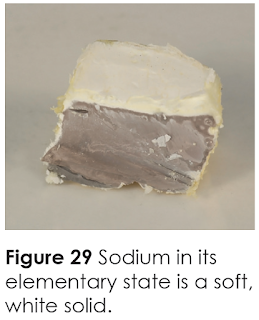Continue

Unlike the noble gases, the alkali metals are highly reactive. The alkali metals include all of the elements in the first column of the periodic table except hydrogen.

Unlike the noble gases, the alkali metals are highly reactive. The alkali metals include all of the elements in the first column of the periodic table except hydrogen.
Figure 28 With the exception of hydrogen, the alkali metals are elements of group 1 of the periodic table.
At room temperature, the alkali metals are relatively soft solids that can be easily cut with a knife. Because of their extreme reactivity, they are often kept submerged in mineral oil. This prevents unwanted reactions of these metals with oxygen in the air.
When they react, alkali metals tend to lose one valence electron to form an ion with a +1 charge. An ion is an atom that has either gained or lost electrons so that it has an electric charge. The high reactivity of alkali metals results from the easy removal of their single valence electron to form +1 ions. These ions are very stable because they have noble gas configurations.
For instance, alkali metals lose one electron to form alkali metal ions when they come into contact with water. The reaction releases hydrogen gas as well as a great deal of heat. Interestingly, if you were to compare the reaction of water with the first three alkali metals—lithium, sodium, and potassium—you would find differences. Potassium reacts most vigorously and lithium reacts least vigorously. Although all three metals readily lose their valence electron, potassium loses its electron most easily and lithium loses its electron least easily.
This trend in reactivity follows a pattern in which reactivity increases as the size of the element increases. Potassium has a larger atomic radius than sodium due to its greater number of electrons. In a potassium atom, the valence electron is far from the potassium nucleus. In a lithium atom, the valence electron is much closer to the lithium nucleus. The greater the distance between the nucleus and the valence electron, the smaller the force of electrical attraction between them. Thus, the valence electron in potassium is more easily removed than the valence electron in lithium.
Alkali metals react to form a
charged ion.
answer :
positively
Fill in the blank.
Fill in the blank.
The reactivity of alkali metal increases as the size of the element
answer :
|
or check the whole part


